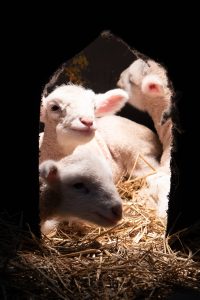On these sub-zero nights, Julissa Navarette ’19 has been sleeping in the conference room at the University Farm, on call for the lambing season. When it’s time, she heads out to the barn for the deliveries. Over 10 days, she’s seen 22 births, including twins and triplets.
A good night’s sleep and a warm bed are only memories, but that’s OK with the graduate assistant who is researching how a ewe’s nutrition affects her offspring, from birth weight to quality of milk to immunities she might pass along.
“It’s been hard work, but I really appreciate the experience and wouldn’t trade it for anything,” she said.
Navarette’s working with students who are on call for deliveries as part of the Department of Agriculture’s calf and lamb watch program. It used to be an independent study program but became so popular, even among non-agriculture majors, that students were being turned away. Assistant Professor Dr. Drew Lugar now offers it in the spring as part of his livestock parturition management course.
Only 2 to 3 percent of students have prior experience with animal births and if they did, it was likely a dog or cat, he said. That means there’s a lot to learn, from watching for twisting tails and restlessness that might indicate labor has started, to gently inserting a tube down a newborn lamb’s throat to deliver its first meal of colostrum.
To give students the experience of assisting with a difficult birth that might require pulling a calf, they put on elbow-length gloves and practice on an artificial cow in the classroom. But, “there’s nothing like the real thing,” Lugar said. University Farm staff are on hand if an animal needs assistance or veterinary care during a delivery.
Every hour of their shift, students go on rounds, more often if an animal is showing signs of labor. It’s normal for students to be a little on edge initially, Lugar said. And the first birth is always memorable.
“One student had a calf born within the first 30 minutes of her shift. She called her mom crying she was so excited.”

That student was Elly Hagen last spring. She pulled on her gloves and headed into the birthing pen with syringes filled with medication. The calf wasn’t standing right away, so Jason Lindbom, University Farm manager, told her to watch for it to nurse over the next several hours. He assured her she’d know what to do and walked away.
“After my boss left and the adrenalin and my emotions came through, it was, ‘Wow, my first calf.’ The tears came,” Hagen said.
A few hours later, the baby stood and nursed.
“It was awesome to see that,” she said. “I was a little choked up watching the baby takes its first steps and nurse from mom for the first time.”
A week later, she was on her fourth birth and was “100 percent confident.” In Hagen’s second season this spring, she’s working the 6 p.m. to 6 a.m. shift.
“I’m out there all the time, whenever they need an extra hand,” she said. “I’m from suburbia of suburbia. They don’t have working farms where I’m from. I was literally sending my mom videos of me driving a tractor.”
The animal industry management junior hopes to breed racehorses and has been working with a professor since her freshman year to build a resume that will hopefully get her a coveted internship with a Kentucky racehorse breeder after graduation.
“Big dreams, that’s for sure,” Hagen said.
Navarette will graduate in December with her master’s degree in animal science. She’s bilingual, and is looking for a career where she can use her language skills, possibly training farm workers, or teaching.
Her family can’t believe that someone who grew up with a fear of everything from insects to dogs is working on a farm, she said.
“Who would have guessed that the little girl who was on the table because she was afraid of a dog would be working with animals?”


